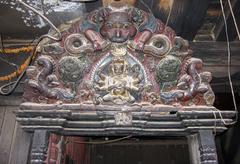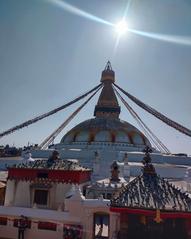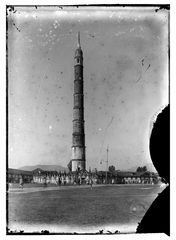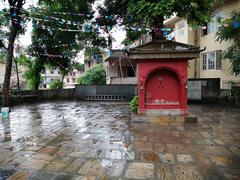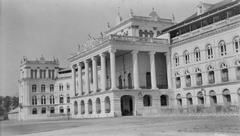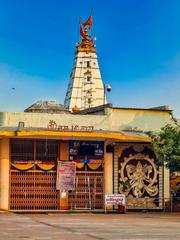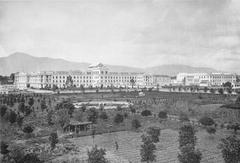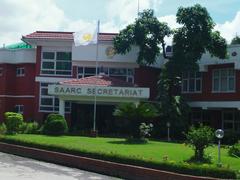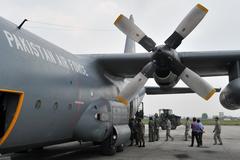
Visiting Nasal Chok: History, Tickets, and Travel Tips
Publication Date: 23/07/2024
Introduction to Nasal Chok
Nasal Chok, situated within the illustrious Kathmandu Durbar Square, is a gem that offers a deep dive into Nepal’s rich cultural tapestry and architectural grandeur. This historic courtyard, dating back to the Malla period (12th to 18th centuries), serves as a testament to the profound historical and cultural evolution of Kathmandu Valley. Constructed during the reign of King Pratap Malla in the 17th century, Nasal Chok embodies the architectural prowess and cultural vibrancy of the Newar artisans (UNESCO) (Lonely Planet). This guide will navigate through the multifaceted aspects of Nasal Chok, from its historical and architectural significance to visitor tips and nearby attractions, ensuring a comprehensive understanding and enriching experience for all visitors.
Contents Overview
- Introduction to Nasal Chok
- Discover the Rich History and Cultural Significance of Nasal Chok
- Essential Visitor Tips for Nasal Chok
- Discover the Best Nearby Attractions When Visiting Nasal Chok
- Summary and Final Thoughts
- Sources and Further Reading
Discover the Rich History and Cultural Significance of Nasal Chok
Historical Background
Nasal Chok, located within the Kathmandu Durbar Square, is a historically significant courtyard that dates back to the Malla period (12th to 18th centuries). Constructed during the reign of King Pratap Malla in the 17th century, Nasal Chok was the center of political and cultural activities. The name “Nasal” is derived from the Newari word for dance, reflecting the courtyard’s use for traditional dance performances and other cultural events (UNESCO) (Lonely Planet).
Architectural Significance
Nasal Chok is renowned for its exquisite architecture, exemplifying the Newar style. The courtyard is surrounded by intricately carved wooden windows and doors. A central feature is the statue of Hanuman, the monkey god, believed to protect the palace and its inhabitants, installed by King Pratap Malla in 1672 (Kathmandu Valley Preservation Trust). The Basantapur Tower, a nine-story structure offering panoramic views of the Kathmandu Valley, is also notable. Both the tower and other buildings were restored following damage from the 2015 earthquake (Nepal Reconstruction Authority).
Cultural and Religious Significance
Nasal Chok holds immense cultural and religious significance. It is a focal point for festivals such as Indra Jatra, a major celebration in honor of Indra, the god of rain. The courtyard is also associated with the Kumari, the living goddess of Kathmandu, who makes ceremonial appearances during festivals (Nepal Tourism Board) (Smithsonian Magazine).
Restoration and Preservation Efforts
Following the 2015 earthquake, extensive restoration efforts were undertaken to repair and preserve Nasal Chok. Organizations such as the Kathmandu Valley Preservation Trust (KVPT) and the Department of Archaeology of Nepal played crucial roles in these efforts, ensuring the courtyard’s historical integrity (KVPT) (UNESCO).
Visitor Information
- Visiting Hours: Nasal Chok is open to visitors daily from 9:00 AM to 5:00 PM.
- Ticket Prices: The entry fee for foreign nationals is NPR 1,000 (approx. USD 8), and for SAARC nationals, it is NPR 150.
- Travel Tips: Wear comfortable shoes due to uneven surfaces. Visit early to avoid crowds.
- Accessibility: Accessible to visitors with mobility issues, though some areas may have limited access.
Visitor Experience
Nasal Chok offers a unique glimpse into Kathmandu’s history and culture, situated within the larger Kathmandu Durbar Square, a UNESCO World Heritage Site. Guided tours provide insights into the site’s historical and cultural significance. Visitors can explore intricately carved buildings, enjoy views from the Basantapur Tower, and witness traditional dance performances during festivals (Lonely Planet). The courtyard’s proximity to other historical landmarks makes it an essential stop (Nepal Tourism Board).
FAQ
- What are the visiting hours for Nasal Chok?
- Nasal Chok is open from 9:00 AM to 5:00 PM daily.
- How much are tickets for Nasal Chok?
- Tickets cost NPR 1,000 for foreign nationals and NPR 150 for SAARC nationals.
- What are some travel tips for visiting Nasal Chok?
- Wear comfortable shoes and visit early to avoid crowds.
Conclusion
Nasal Chok stands as a testament to the rich history and cultural heritage of Kathmandu. Its architectural beauty, cultural significance, and preservation efforts make it a must-visit destination.
Essential Visitor Tips for Nasal Chok
Best Time to Visit
The best times to visit Nasal Chok are during the autumn (September to November) and spring (March to May) seasons. During these periods, the weather is pleasant, making it ideal for exploring historical and cultural sites. The monsoon season (June to August) brings heavy rainfall, hindering outdoor activities, while winter (December to February) can be quite cold.
Entry Fees and Timings
The entry fee for Nasal Chok is NPR 1,000 for foreign nationals and NPR 150 for SAARC nationals. The site is open from 9:00 AM to 5:00 PM daily. For the latest updates, check the official Kathmandu Durbar Square website.
Guided Tours
Hiring a local guide can enhance your experience. Guided tours are available at the entrance and typically cost around NPR 1,500 to NPR 2,000 for a two-hour tour.
Dress Code and Etiquette
Visitors should dress modestly, with long pants or skirts and tops that cover the shoulders. Shoes should be removed before entering any temples or religious structures.
Photography
Photography is generally allowed, but be respectful. Some areas, particularly inside temples, may have restrictions. Professional equipment may require special permits.
Safety and Security
Nasal Chok is relatively safe, but basic precautions should be taken. Keep an eye on your belongings and avoid carrying large amounts of cash. Be cautious of pickpockets in crowded areas.
Accessibility
While Nasal Chok is accessible to most visitors, those with mobility issues may face challenges due to uneven surfaces and steps. Inform your guide or tour operator in advance if special assistance is required.
Local Customs and Traditions
Respect local customs and traditions. Greet locals with a “Namaste” and avoid touching anyone’s head. When visiting temples, walk clockwise around stupas or shrines and avoid pointing your feet towards religious objects or people.
Nearby Attractions
Nearby attractions within Kathmandu Durbar Square include the Hanuman Dhoka Palace, Kumari Ghar, and the Taleju Temple.
Food and Refreshments
There are several cafes and restaurants around Kathmandu Durbar Square. Popular options include the Newa Momo Restaurant and the Himalayan Java Coffee.
Souvenirs and Shopping
Numerous stalls and shops around Nasal Chok sell traditional handicrafts, jewelry, and souvenirs. Bargaining is common in local markets.
Health and Safety Precautions
Ensure you are up-to-date with routine vaccinations. Carry a basic first aid kit and consider purchasing travel insurance that covers medical emergencies.
Transportation
Nasal Chok is easily accessible by various modes of transportation, including taxis, rickshaws, and local buses. Many tour operators offer packages that include transportation to and from the site.
FAQ
Q: What are the Nasal Chok visiting hours?
- A: Nasal Chok is open from 9:00 AM to 5:00 PM daily.
Q: How much are the Nasal Chok tickets?
- A: As of 2024, the entry fee for foreign nationals is NPR 1,000, and for SAARC nationals, it is NPR 150.
Q: Are guided tours available at Nasal Chok?
- A: Yes, guided tours are available at the entrance, typically costing around NPR 1,500 to NPR 2,000 for a two-hour tour.
Q: What should I wear when visiting Nasal Chok?
- A: Dress modestly, with long pants or skirts and tops that cover the shoulders. Remove shoes before entering any temples or religious structures.
Q: Is photography allowed at Nasal Chok?
- A: Photography is generally allowed, but be respectful of local customs. Some areas may have restrictions, and professional equipment may require special permits.
Conclusion
By following these tips, visitors can ensure a safe, respectful, and enriching experience at Nasal Chok, immersing themselves in the rich history and culture of Kathmandu.
Discover the Best Nearby Attractions When Visiting Nasal Chok
Kathmandu Durbar Square
Kathmandu Durbar Square, also known as Hanuman Dhoka Durbar Square, is a UNESCO World Heritage Site located just a short walk from Nasal Chok. This historic square is a complex of palaces, courtyards, and temples, which served as the royal palace for the Malla kings and later the Shah dynasty. Key attractions within the square include the Taleju Temple, the Jagannath Temple, and the Kumari Ghar, which is the residence of the living goddess, Kumari (UNESCO).
Swayambhunath Stupa (Monkey Temple)
Approximately 2.5 kilometers from Nasal Chok, the Swayambhunath Stupa, commonly known as the Monkey Temple, is one of the oldest and most revered religious sites in Nepal. Perched atop a hill, the stupa offers panoramic views of the Kathmandu Valley. The site is adorned with numerous shrines and temples, some dating back to the Licchavi period (Lonely Planet).
Thamel
Thamel is a bustling commercial neighborhood located about 1.5 kilometers from Nasal Chok. Known as the tourist hub of Kathmandu, Thamel is filled with shops, restaurants, bars, and hotels catering to travelers. The area is famous for its vibrant nightlife, live music, and a wide range of cuisines (Rough Guides).
Garden of Dreams
Located about 1 kilometer from Nasal Chok, the Garden of Dreams is a neo-classical garden in the heart of Kathmandu. Built in the 1920s, the garden features European-inspired architecture, fountains, pavilions, and pergolas (Garden of Dreams).
Pashupatinath Temple
Situated approximately 5 kilometers from Nasal Chok, the Pashupatinath Temple is one of the most significant Hindu temples dedicated to Lord Shiva. The temple complex is a UNESCO World Heritage Site and attracts thousands of pilgrims and tourists each year (UNESCO).
Boudhanath Stupa
Located about 6 kilometers from Nasal Chok, the Boudhanath Stupa is one of the largest stupas in Nepal and a UNESCO World Heritage Site (Boudhanath Stupa).
Patan Durbar Square
Patan Durbar Square, located about 5 kilometers from Nasal Chok, showcases the rich cultural heritage of the Kathmandu Valley. The square is home to the ancient royal palace of the Malla kings of Lalitpur and is surrounded by numerous temples and statues (UNESCO).
Bhaktapur Durbar Square
Bhaktapur Durbar Square, located about 13 kilometers from Nasal Chok, is a well-preserved medieval city that offers a glimpse into Nepal’s rich history and culture. The square is a UNESCO World Heritage Site and is known for its stunning architecture and vibrant festivals (Bhaktapur Durbar Square).
Changu Narayan Temple
Located about 20 kilometers from Nasal Chok, the Changu Narayan Temple is one of the oldest Hindu temples in Nepal, dating back to the 4th century (UNESCO).
Kopan Monastery
Kopan Monastery, located about 8 kilometers from Nasal Chok, is a Tibetan Buddhist monastery that offers meditation retreats and courses on Buddhism (Kopan Monastery).
FAQ
1. What are the visiting hours for Nasal Chok?
- Nasal Chok is open daily from 9:00 AM to 5:00 PM.
2. How much are the tickets for Nasal Chok?
- The entrance fee is NPR 1,000 for foreign tourists and NPR 150 for SAARC nationals.
3. What is the best time to visit Nasal Chok?
- The best time to visit Nasal Chok is during the autumn (September to November) and spring (March to May) seasons.
4. Are there guided tours available?
- Yes, guided tours are available and can be booked through various tour operators in Kathmandu.
5. What are some good photographic spots near Nasal Chok?
- Kathmandu Durbar Square and the Swayambhunath Stupa offer excellent photographic opportunities.
Conclusion
Whether you’re a history buff, a spiritual seeker, or simply looking to experience the vibrant culture of Kathmandu, the attractions near Nasal Chok have something for everyone. Don’t forget to check out our other guides and download the Audiala app for more travel tips and updates.
Summary and Final Thoughts
Nasal Chok stands as a remarkable emblem of Kathmandu’s rich historical and cultural heritage. Its intricate architecture, cultural significance, and diligent restoration efforts post the 2015 earthquake underscore the courtyard’s enduring legacy. Visitors are invited to immerse themselves in the vibrant traditions, explore the surrounding attractions, and appreciate the efforts taken to preserve this historical marvel. To stay updated on events and visitor information, consider following the official Kathmandu Durbar Square website and related social media channels (UNESCO) (Lonely Planet).
Sources and Further Reading
- UNESCO. (n.d.). Kathmandu Valley. Retrieved from https://whc.unesco.org/en/list/121/
- Lonely Planet. (n.d.). Kathmandu Durbar Square. Retrieved from https://www.lonelyplanet.com/nepal/kathmandu/attractions/kathmandu-durbar-square/a/poi-sig/1145567/357551
- Lonely Planet. (n.d.). Swayambhunath Stupa. Retrieved from [https://www.lonelyplanet.com/nepal/kathmandu/attractions/swayambhunath-stupa/a/poi-sig/1143554/357551](https://www.lonelyplanet.com/nepal/kathmandu/attractions/swayambhunath-stupa/a/

